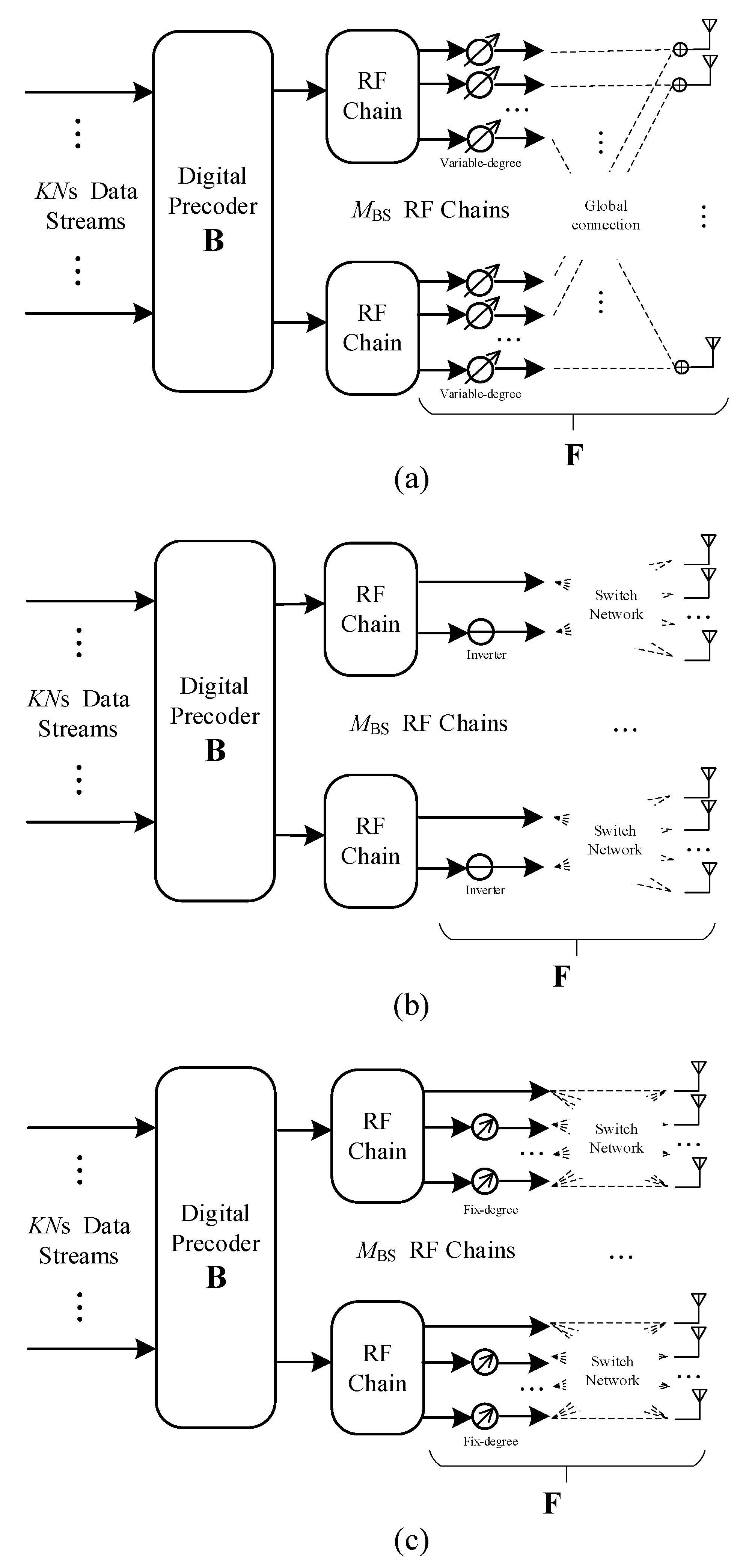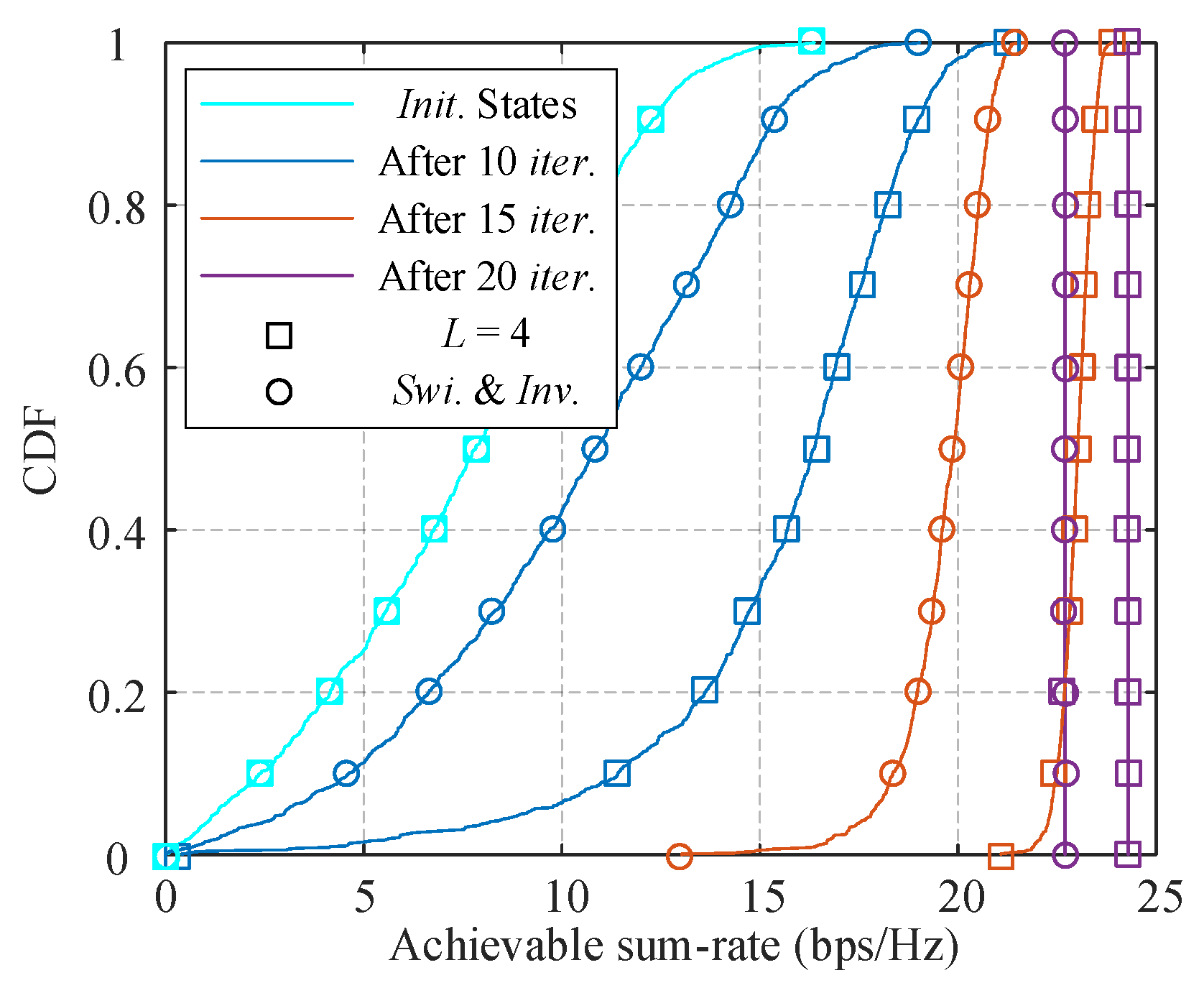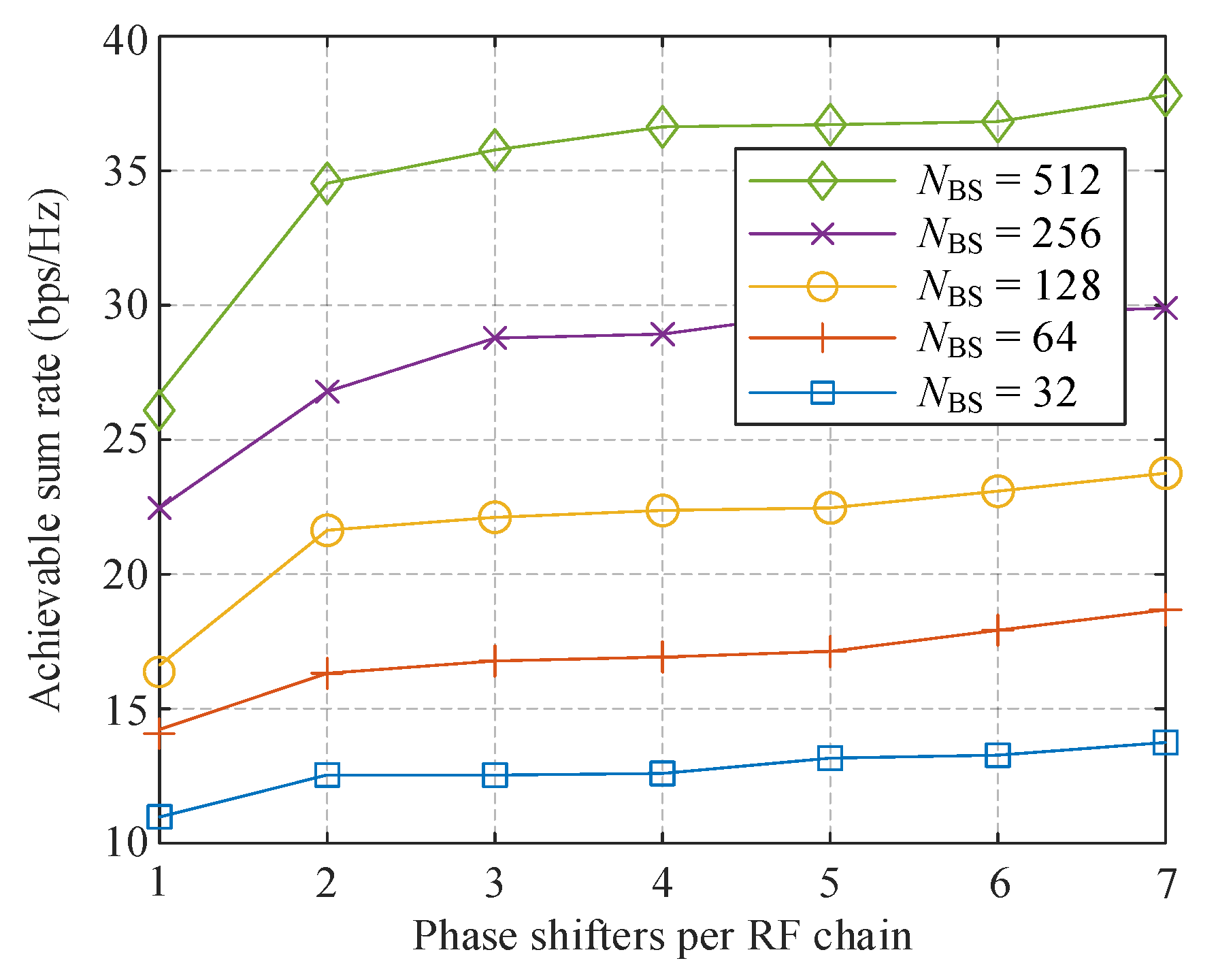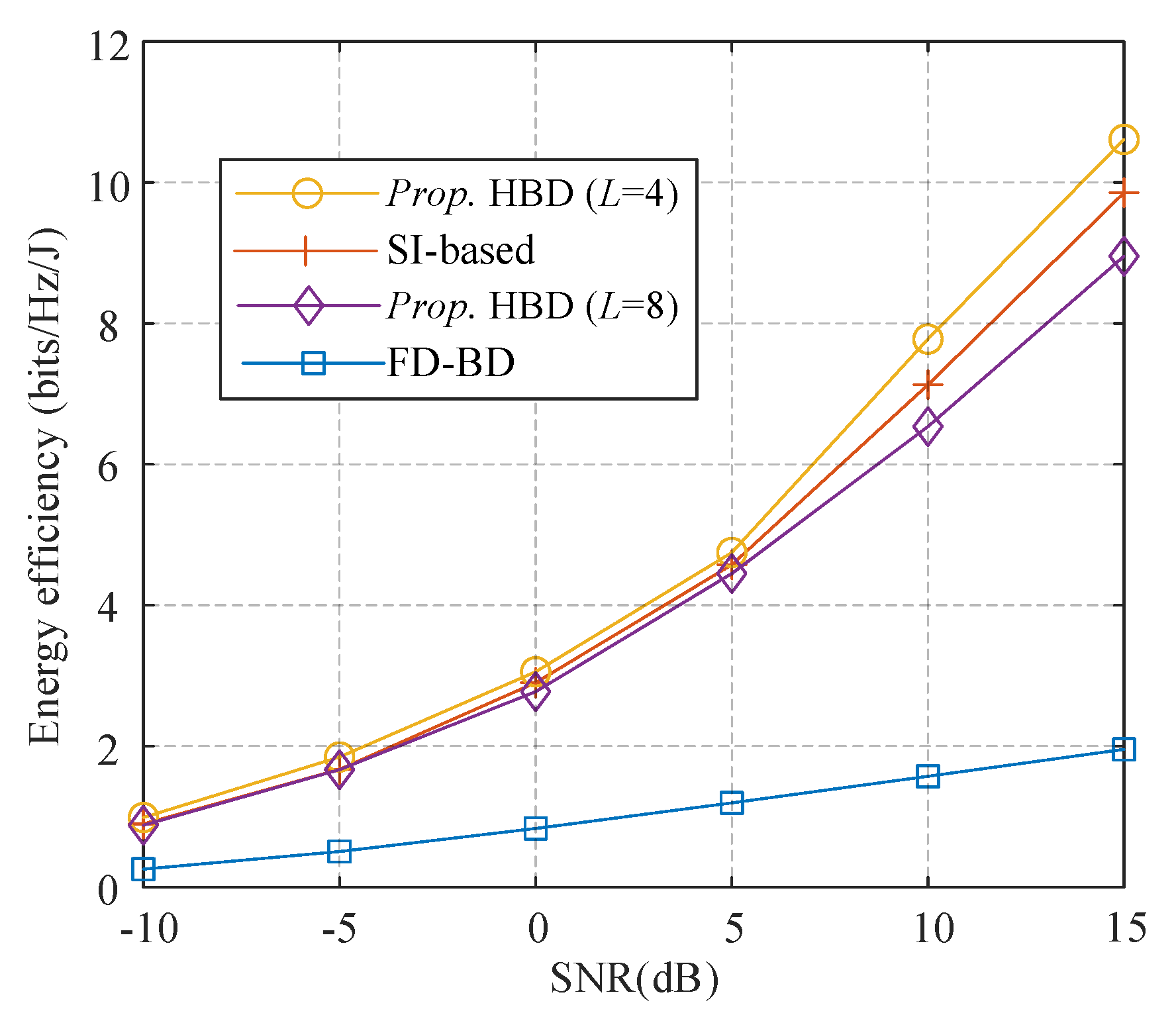Machine Learning-Inspired Hybrid Precoding for mmWave MU-MIMO Systems with Domestic Switch Network
Abstract
1. Introduction
- A novel hybrid precoding structure based on DSN is proposed. We develop a CE-based framework to generate the hybrid precoding matrix in an iterative way.
- For single-antenna MSs, we extend the SI-based hybrid precoding algorithm to multiphase hybrid ZF. For multiple-antenna MSs, we formulate how to cancel inter-user and inter-stream interference via BD decomposition.
- We develop a Dinkelbach-method (DM) based algorithm to maximize the energy efficiency in which the number of active antennas is dynamically adapted.
2. System Model
2.1. System Model
2.2. Channel Model
2.3. Hybrid Precoder
3. Hybrid Precoding
3.1. Hybrid-ZF and Array Gain Harvesting
| Algorithm 1: Proposed hybrid-ZF algorithm |
| Input: H, σ2 |
| 1: Loop: |
| 2: for s in 1…S do |
| 3: Generate Fs according to Pm; |
| 4: Calculate Bs and Rs by Equations (12)–(15); |
| 5: for e in 1…E do |
| 6: Calculate we by Equation (17); |
| 7: end for |
| 8: Check convergency; |
| 9: for n in 1…NBS do |
| 10: for l in 1…L do |
| 11: Update by Equation (22); |
| 12: end for |
| 13: end for |
| 14: m←m + 1; |
| 15: end loop |
| 16: return Fopt, Bopt and Ropt. |
3.2. Hybrid Block Diagonalization
3.3. Water-Filling Power Allocation
| Algorithm 2: Proposed hybrid-BD algorithm |
| Input: Hk, σ2 |
| 1: Loop: |
| 2: for s in 1,…,S do |
| 3: Generate Fs according to Pm; |
| 4: Calculate Bs and by Equations (32) and (33); |
| 5: Calculate Δn by Equation (41) and the corresponding spectral efficiency Rs; |
| 6: end for |
| 7: for e in 1,…,E do |
| 8: Calculate the weight we; |
| 9: end for |
| 10: Check convergency; |
| 11: for n in 1,…,N BS do |
| 12: for l in 1,…,L do |
| 13: Update |
| 14: end for |
| 15: end for |
| 16: m←m + 1; |
| 17: end loop |
| 18: return Fopt, Bopt, and |
4. Energy Efficiency Maximization
| Algorithm 3: DM-based energy efficiency optimization |
| 1: Calculate R(F(0)) via Algorithm I or II and corresponding P(F(0)). |
| 2: Initialize ψ(0) = R(F(0)) / P(F(0)), m = 0. |
| 3: while Φ(F(m), ψ(m)) ≥ 0 do |
| 4: m = m + 1. |
| 5: Maximize Φ(F(m), ψ(m)) via CE minimization. |
| 6: Update ψ(m) and Φ(F(m), ψ(m)). |
| 7: if Φ(F(m), ψ(m)) < 0 |
| 8: break; |
| 9: end if |
| 10: end while |
| 11: return F(m) and ψ(m). |
5. Simulation Results
5.1. Performance of Proposed Hybrid-ZF
5.2. Performance of Proposed Hybrid-BD
5.3. Performance of Proposed Energy Efficiency Optimization Algorithm
6. Conclusions
Author Contributions
Funding
Institutional Review Board Statement
Informed Consent Statement
Conflicts of Interest
References
- Han, S.; Chih-Lin, I.; Xu, Z.; Rowell, C. Large-scale antenna systems with hybrid analog and digital beamforming for milli-meter wave 5G. IEEE Commun. Mag. 2015, 53, 186–194. [Google Scholar] [CrossRef]
- Marzetta, T.L. Noncooperative Cellular Wireless with Unlimited Numbers of Base Station Antennas. IEEE Trans. Wirel. Commun. 2010, 9, 3590–3600. [Google Scholar] [CrossRef]
- Gao, Z.; Dai, L.; Mi, D.; Wang, Z.; Imran, M.A.; Shakir, M.Z. MmWave massive-MIMO-based wireless backhaul for the 5G ultra-dense network. IEEE Wirel. Commun. 2015, 22, 13–21. [Google Scholar] [CrossRef]
- Ayach, O.E.I.; Rajagopal, S.; Abu-Surra, S.; Pi, Z.; Heath, R.W., Jr. Spatial sparse precoding in millimeter wave MIMO systems. IEEE Trans. Wireless Commun. 2014, 13, 1499–1513. [Google Scholar] [CrossRef]
- Kutty, S.; Sen, D. Beamforming for Millimeter Wave Communications: An Inclusive Survey. IEEE Commun. Surv. Tutor. 2016, 18, 949–973. [Google Scholar] [CrossRef]
- Molisch, A.F.; Ratnam, V.V.; Han, S.; Li, Z.; Nguyen, S.L.H.; Li, L.; Haneda, K. Hybrid Beamforming for Massive MIMO: A Survey. IEEE Commun. Mag. 2017, 55, 134–141. [Google Scholar] [CrossRef]
- Roh, W.; Seol, J.Y.; Park, J.; Lee, B.; Lee, J.; Kim, Y.; Cho, J.; Cheun, K.; Aryanfar, F. Millimeter-wave beamforming as an enabling technology for 5G cellular communications: Theoretical feasibility and prototype results. IEEE Commun. Mag. 2014, 52, 106–113. [Google Scholar] [CrossRef]
- Heath, R.W.; Gonzalez-Prelcic, N.; Rangan, S.; Roh, W.; Sayeed, A.M. An Overview of Signal Processing Techniques for Millimeter Wave MIMO Systems. IEEE J. Sel. Top. Signal Process. 2016, 10, 436–453. [Google Scholar] [CrossRef]
- Song, X.; Kuhne, T.; Caire, G. Fully-Connected vs. Sub-Connected Hybrid Precoding Architectures for mmWave MU-MIMO. In Proceedings of the ICC 2019—2019 IEEE International Conference on Communications (ICC), Institute of Electrical and Electronics Engineers (IEEE), Shanghai, China, 20–24 May 2019; pp. 1–7. [Google Scholar]
- Yu, X.; Shen, J.-C.; Zhang, J.; Letaief, K.B. Alternating Minimization Algorithms for Hybrid Precoding in Millimeter Wave MIMO Systems. IEEE J. Sel. Top. Signal Process. 2016, 10, 485–500. [Google Scholar] [CrossRef]
- Huang, H.; Song, Y.; Yang, J.; Gui, G.; Adachi, F. Deep-learning-based millimeter-wave massive MIMO for hybrid pre-coding. IEEE Trans. Veh. Technol. 2019, 68, 3027–3032. [Google Scholar] [CrossRef]
- Yan, L.; Han, C.; Yuan, J. A Dynamic Array-of-Subarrays Architecture and Hybrid Precoding Algorithms for Terahertz Wireless Communications. IEEE J. Sel. Areas Commun. 2020, 38, 2041–2056. [Google Scholar] [CrossRef]
- Rusek, F.; Persson, D.; Lau, B.K.; Larsson, E.G.; Marzetta, T.L.; Tufvesson, F. Scaling Up MIMO: Opportunities and Challenges with Very Large Arrays. IEEE Signal Process. Mag. 2013, 30, 40–60. [Google Scholar] [CrossRef]
- Liang, L.; Xu, W.; Dong, X. Low-Complexity Hybrid Precoding in Massive Multiuser MIMO Systems. IEEE Wirel. Commun. Lett. 2014, 3, 653–656. [Google Scholar] [CrossRef]
- Ni, W.; Dong, X. Hybrid Block Diagonalization for Massive Multiuser MIMO Systems. IEEE Trans. Commun. 2015, 64, 201–211. [Google Scholar] [CrossRef]
- Hanif, M.; Yang, H.; Boudreau, G.; Sich, E.; Seyedmehdi, H. Low-complexity hybrid precoding for multi-user massive MIMO systems: A hybrid EGT/ZF approach. IET Commun. 2017, 11, 765–771. [Google Scholar] [CrossRef]
- Flores, A.R.; De Lamare, R.C.; Clerckx, B. Linear Precoding and Stream Combining for Rate Splitting in Multiuser MIMO Systems. IEEE Commun. Lett. 2020, 24, 890–894. [Google Scholar] [CrossRef]
- Ngo, H.Q.; Larsson, E.G.; Marzetta, T.L. Energy and Spectral Efficiency of Very Large Multiuser MIMO Systems. IEEE Trans. Commun. 2013, 61, 1436–1449. [Google Scholar] [CrossRef]
- Tsinos, C.G.; Maleki, S.; Chatzinotas, S.; Ottersten, B. On the Energy-Efficiency of Hybrid Analog–Digital Transceivers for Single- and Multi-Carrier Large Antenna Array Systems. IEEE J. Sel. Areas Commun. 2017, 35, 1980–1995. [Google Scholar] [CrossRef]
- Kaushik, A.; Vlachos, E.; Thompson, J. Energy Efficiency Maximization of Millimeter Wave Hybrid MIMO Systems with Low Resolution DACs. In Proceedings of the ICC 2019—2019 IEEE International Conference on Communications (ICC), Institute of Electrical and Electronics Engineers (IEEE), Shanghai, China, 20–24 May 2019; pp. 1–6. [Google Scholar]
- Vlachos, E.; Kaushik, A.; Thompson, J. Energy Efficient Transmitter with Low Resolution DACs for Massive MIMO with Partially Connected Hybrid Architecture. In Proceedings of the 2018 IEEE 87th Vehicular Technology Conference (VTC Spring); Institute of Electrical and Electronics Engineers (IEEE), Porto, Portugal, 3–6 June 2018; pp. 1–5. [Google Scholar]
- Gao, X.; Dai, L.; Sun, Y.; Han, S.; Chih-Lin, I. Machine learning in- spired energy-efficient hybrid precoding for mmWave massive MIMO. In Proceedings of the 2017 IEEE International Conference on Communications (ICC), Paris, France, 21–25 May 2017; pp. 1–6. [Google Scholar]
- Tian, M.; Zhang, J.; Zhao, Y.; Yuan, L.; Yang, J.; Gui, G. Switch and Inverter Based Hybrid Precoding Algorithm for mmWave Massive MIMO System: Analysis on Sum-Rate and Energy-Efficiency. IEEE Access 2019, 7, 49448–49455. [Google Scholar] [CrossRef]
- Kroese, D.P.; Porotsky, S.; Rubinstein, R.Y. The Cross-Entropy Method for Continuous Multi-Extremal Optimization. Methodol. Comput. Appl. Probab. 2006, 8, 383–407. [Google Scholar] [CrossRef]
- Costa, A.; Jones, O.D.; Kroese, D. Convergence properties of the cross-entropy method for discrete optimization. Oper. Res. Lett. 2007, 35, 573–580. [Google Scholar] [CrossRef]
- Margolin, L. On the Convergence of the Cross-Entropy Method. Ann. Oper. Res. 2005, 134, 201–214. [Google Scholar] [CrossRef]
- Dambreville, F. Cross-entropy method: Convergence issues for extended implementation. In Proceedings of the Rare Event Simulation Conference (RESIM), Bamberg, Germany, 8–10 October 2006. [Google Scholar]
- Hu, J.; Hu, P. On the performance of the Cross-Entropy method. In Proceedings of the 2009 Winter Simulation Conference (WSC); Institute of Electrical and Electronics Engineers (IEEE), Austin, TX, USA, 13–16 December 2009; pp. 459–468. [Google Scholar]
- Zhang, Y.; Dong, X.; Zhang, Z. Machine Learning-Based Hybrid Precoding with Low-Resolution Analog Phase Shifters. IEEE Commun. Lett. 2021, 25, 186–190. [Google Scholar] [CrossRef]
- Hemadeh, I.A.; Satyanarayana, K.; El-Hajjar, M.; Hanzo, L. Millimeter-Wave Communications: Physical Channel Models, Design Considerations, Antenna Constructions, and Link-Budget. IEEE Commun. Surv. Tutor. 2017, 20, 870–913. [Google Scholar] [CrossRef]
- Alkhateeb, A.; El Ayach, O.; Leus, G.; Heath, R.W. Channel Estimation and Hybrid Precoding for Millimeter Wave Cel-lular Systems. IEEE J. Sel. Topics Signal Process. 2014, 8, 831–846. [Google Scholar] [CrossRef]
- Bajwa, W.U.; Haupt, J.; Sayeed, A.M.; Nowak, R. Compressed Channel Sensing: A New Approach to Estimating Sparse Multipath Channels. Proc. IEEE 2010, 98, 1058–1076. [Google Scholar] [CrossRef]
- Bao, X.; Feng, W.; Zheng, J.; Li, J. Deep CNN and Equivalent Channel Based Hybrid Precoding for mmWave Massive MIMO Systems. IEEE Access 2020, 8, 19327–19335. [Google Scholar] [CrossRef]
- Mendez-Rial, R.; Rusu, C.; Gonzalez-Prelcic, N.; Alkhateeb, A.; Heath, R.W., Jr. Hybrid MIMO architectures for millime-ter wave communications: Phase shifters or switches? IEEE Access 2016, 4, 247–267. [Google Scholar] [CrossRef]
- Rubinstein, R.Y.; Kroese, D.P. The Cross-Entropy Method: A Unified Approach to Combinatorial Optimization, Monte-Carlo Simulation and Machine Learning; Springer: New York, NY, USA, 2004. [Google Scholar]
- Hu, C.; Liu, J.; Liao, X.; Liu, Y.; Wang, J. A Novel Equivalent Baseband Channel of Hybrid Beamforming in Massive Mul-tiuser MIMO Systems. IEEE Commun. Lett. 2018, 22, 764–767. [Google Scholar] [CrossRef]
- Boyd, S.; Vandenberghe, L. Convex Optimization; Cambridge University Press (CUP): Cambridge, UK, 2004. [Google Scholar]
- Hei, Y.; Yu, S.; Liu, C.; Li, W.; Yang, J. Energy-Efficient Hybrid Precoding for mmWave MIMO Systems with Phase Modu-lation Array. IEEE Trans. Green Commun. Netw. 2020, 4, 678–688. [Google Scholar] [CrossRef]
- Dinkelbach, W. On Nonlinear Fractional Programming. Manag. Sci. 1967, 13, 492–498. [Google Scholar] [CrossRef]
- Alkhateeb, A.; Leus, G., Jr.; Heath, R.W. Limited Feedback Hybrid Precoding for Multi-User Millimeter Wave Systems. IEEE Trans. Wirel. Commun. 2015, 14, 6481–6494. [Google Scholar] [CrossRef]
- Nguyen, N.T.; Lee, K. Unequally Sub-Connected Architecture for Hybrid Beamforming in Massive MIMO Systems. IEEE Trans. Wirel. Commun. 2019, 19, 1127–1140. [Google Scholar] [CrossRef]









Publisher’s Note: MDPI stays neutral with regard to jurisdictional claims in published maps and institutional affiliations. |
© 2021 by the authors. Licensee MDPI, Basel, Switzerland. This article is an open access article distributed under the terms and conditions of the Creative Commons Attribution (CC BY) license (https://creativecommons.org/licenses/by/4.0/).
Share and Cite
Li, X.; Huang, Y.; Heng, W.; Wu, J. Machine Learning-Inspired Hybrid Precoding for mmWave MU-MIMO Systems with Domestic Switch Network. Sensors 2021, 21, 3019. https://doi.org/10.3390/s21093019
Li X, Huang Y, Heng W, Wu J. Machine Learning-Inspired Hybrid Precoding for mmWave MU-MIMO Systems with Domestic Switch Network. Sensors. 2021; 21(9):3019. https://doi.org/10.3390/s21093019
Chicago/Turabian StyleLi, Xiang, Yang Huang, Wei Heng, and Jing Wu. 2021. "Machine Learning-Inspired Hybrid Precoding for mmWave MU-MIMO Systems with Domestic Switch Network" Sensors 21, no. 9: 3019. https://doi.org/10.3390/s21093019
APA StyleLi, X., Huang, Y., Heng, W., & Wu, J. (2021). Machine Learning-Inspired Hybrid Precoding for mmWave MU-MIMO Systems with Domestic Switch Network. Sensors, 21(9), 3019. https://doi.org/10.3390/s21093019





